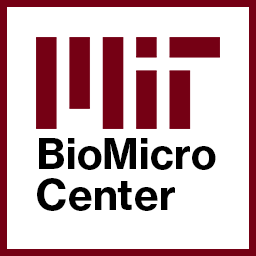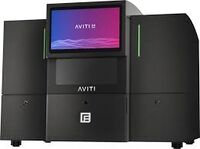BioMicroCenter:Element Sequencing: Difference between revisions
| (36 intermediate revisions by 4 users not shown) | |||
| Line 1: | Line 1: | ||
== Element Sequencing == | == Element Sequencing == | ||
The Center currently hosts an AVITI24 platform | The Center currently hosts an AVITI24 platform from [https://www.elementbiosciences.com/ Element Biosciences]. | ||
AVITI24 platform supports both sequencing and cytoprofiling. For most sequencing needs, the Center will use Element's Freestyle chemistry kits. | |||
{| | {| | ||
| | |||
{| class="wikitable" border=1 | {| class="wikitable" border=1 | ||
!Service | !width=100|Service | ||
!Element Sequencing | !width=250|Element Sequencing | ||
|- | |- | ||
|SUBMISSION || Illumina OR Element libraries | |SUBMISSION || Illumina OR Element libraries | ||
| Line 40: | Line 27: | ||
| | | | ||
*FASTQ (stored 1 year) | *FASTQ (stored 1 year) | ||
|- | |- | ||
|QUALITY CONTROL | |QUALITY CONTROL | ||
| Line 57: | Line 43: | ||
|- | |- | ||
|} | |} | ||
| valign='top' | | |||
{| | |||
=== ANCHORS === | |||
Element supports both Illumina anchors (P5/P7) using 'Freestyle' chemistry and and Element Anchors (SP5/SP27) for 'Adept' chemistry. For runs in the BMC, P5/P7 anchored library (Illumina) are preferred. Element Adept libraries (SP5/SP27) require a 5'-phosphate on the forward end in order to circularize and sequence. <BR><BR> | |||
=== INDEXING === | |||
Compared to an Illumina platform, AVITI24 reads are similar in read direction to Illumina's Forward Strand workflow for Dual Indexed Libraries. Indexes are read from antisense primers to the forward and reverse reads with the P7 side read first (index 1). Indexes are therefore antisense to the ordered oligos in traditional chemistry. Index sequences should be provided AS READ and not as ordered. <BR> | |||
* Custom primer submission: 70 uL at 100 uM for Read 1, all other reads require 40 uL at 100 uM. | |||
* Custom primers must be compatible with TruSeq, Nextera, TruSeq, smRNA and Element sequencing primers | |||
===SINGLE LANE === | |||
Each lane of the AVITI24 can be loaded independently. Flowcells require both lanes to be filled to be run. | |||
Custom primers must be designed to not interfere with other user's samples. | |||
All other requests require a full flowcell. 300PE kits only have a single lane. | |||
=== MINIMUM READS === | |||
Minimum reads per lane are guaranteed if: | |||
*the BMC has performed quality control, | |||
*the samples have high diversity, especially within the first 5 bases of read 1, and | |||
*submitted libraries are at least 2 nM. | |||
|} | |||
|} | |||
== The AVITI24 Platform == | == The AVITI24 Platform == | ||
{| class="wikitable" border=1 | {| class="wikitable" border=1 | ||
!width=100| | !width=100| | ||
!width=250| | !width=250| AVITI24 | ||
!width= | !width=150| NOTES | ||
|- | |- | ||
|'''SEQUENCER'''||[[Image:Element_AVITI.jpg|center|200px]]|| | |'''SEQUENCER'''||[[Image:Element_AVITI.jpg|center|200px]]|| | ||
|- | |- | ||
| '''READS/FLOWCELL'''<BR> Low number is minimum per lane for standard | | '''READS/FLOWCELL'''<BR> Low number is minimum per lane for standard P5/P7 libraries.|| | ||
* | * 250M HQ read pairs (150 for PE300) | ||
|- | |- | ||
|'''RUN TIME'''|| | |'''RUN TIME'''|| | ||
| Line 75: | Line 82: | ||
|- | |- | ||
|'''KITS AVAILABLE'''|| | |'''KITS AVAILABLE'''|| | ||
* 2x75 Cloudbreak High | * 2x75 Cloudbreak FS High | ||
* 2x150 Cloudbreak High | * 2x150 Cloudbreak FS High | ||
* 2x300 Cloudbreak High | * 2x300 Cloudbreak FS High | ||
|| - Single end supported <br> - each kit comes with 34 additional cycles | || - Single end supported <br> - each kit comes with 34 additional cycles | ||
|- | |- | ||
|'''KEY NOTES'''|| | |'''KEY NOTES'''|| | ||
* 4-color chemistry | * 4-color chemistry | ||
* | * Random flow cell | ||
* 2-lanes per flow cell | * 2-lanes per flow cell (1 for 300PE) | ||
* Q40+ > 80% | * Q40+ > 80% | ||
* Low-binding surface chemistry | * Low-binding surface chemistry | ||
|- | |- | ||
|'''THANKS TO'''|| | |'''THANKS TO'''|| | ||
* Element Biosciences | * Element Biosciences / Scott Ritterbush | ||
|} | |} | ||
The AVITI24 can run 2 flow cells per run, each hosting 2 independently-addressable lanes. Both lanes are washed with the same reagents. Element currently offers kits with 150 and 300 cycles, both supporting 2 lanes, as well as a 600 cycle kit that supports a single lane. Index hopping rates are similar to non-patterned Illumina, limiting the need for UDI's. The AVITI24 can also perform direct in sample sequencing which includes spatial imaging of RNA, proteins, phospho-proteins, and cell morphology using [https://www.elementbiosciences.com/products/aviti24/cytoprofiling/ Teton chemistry] for cytoprofiling. | |||
<!-- hidden | |||
== Cytoprofiling with AVITI24 == | |||
[[Image:DISS_example.jpg|thumb|right|200px|Example of Teton imaging from Element Biosciences website]] | |||
A user can optimize the assay before attempting a Teton Run. This test will require an optimization kit. Optimization is similar to creating a slide for a Teton run. The standard steps of coating (or not) that slide, loading and culturing cells prior to fixing are all similar. Instead of running the optimization slide on the AVITI24, the optimization slide should be inspected with a fluorescence objective. This process requires a separate kit from the actual slide kits. | |||
[[Image:OptimizationSlide.jpg|thumb|middle|Lamason Lab Slide provided from Element Biosciences]] | |||
Users can pick up a 1- or 12-well Teton Slide kit from the Center. Currently, Poly-L-Lysine-coated and uncoated slide kits are available. Uncoated slides must be coated as laid out in the protocol and users should ensure that cell fixation is ideal for one of the possible coatings which are not PLL (currently: Collagen, Fibronectin, Gelatin, Laminin, Matrigel). Cells are loaded and cultured for the desired amount of time on coated slides. Cells are fixed and the Teton Slide may be stored at 2-8C for up to 30 days or may be run immediately on the AVITI24. | |||
For a Teton Run, cells are washed in the appropriate Cell Paint reagents for a fixed panel or custom panel cytoprofiling assay. A single Teton slide can be used to infer Morphology, RNA within the cells, Protein and also direct in situ sequencing up to 100nt which is not robust enough for transcriptomics, but is sufficient for investigating CRISPR or TCR or other short sequences of interest. | |||
--> | |||
Latest revision as of 15:56, 20 July 2025
Element Sequencing[edit]
The Center currently hosts an AVITI24 platform from Element Biosciences. AVITI24 platform supports both sequencing and cytoprofiling. For most sequencing needs, the Center will use Element's Freestyle chemistry kits.
|
ANCHORS[edit]Element supports both Illumina anchors (P5/P7) using 'Freestyle' chemistry and and Element Anchors (SP5/SP27) for 'Adept' chemistry. For runs in the BMC, P5/P7 anchored library (Illumina) are preferred. Element Adept libraries (SP5/SP27) require a 5'-phosphate on the forward end in order to circularize and sequence. INDEXING[edit]Compared to an Illumina platform, AVITI24 reads are similar in read direction to Illumina's Forward Strand workflow for Dual Indexed Libraries. Indexes are read from antisense primers to the forward and reverse reads with the P7 side read first (index 1). Indexes are therefore antisense to the ordered oligos in traditional chemistry. Index sequences should be provided AS READ and not as ordered.
SINGLE LANE[edit]Each lane of the AVITI24 can be loaded independently. Flowcells require both lanes to be filled to be run. Custom primers must be designed to not interfere with other user's samples. All other requests require a full flowcell. 300PE kits only have a single lane. MINIMUM READS[edit]Minimum reads per lane are guaranteed if:
|
The AVITI24 Platform[edit]
The AVITI24 can run 2 flow cells per run, each hosting 2 independently-addressable lanes. Both lanes are washed with the same reagents. Element currently offers kits with 150 and 300 cycles, both supporting 2 lanes, as well as a 600 cycle kit that supports a single lane. Index hopping rates are similar to non-patterned Illumina, limiting the need for UDI's. The AVITI24 can also perform direct in sample sequencing which includes spatial imaging of RNA, proteins, phospho-proteins, and cell morphology using Teton chemistry for cytoprofiling.

